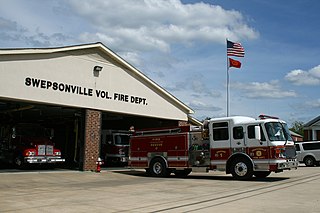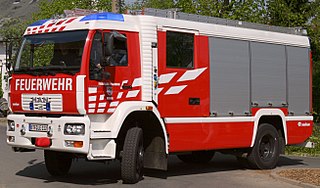
The Canadian Armed Forces are the unified military forces of Canada, including land, sea, and air commands referred to as the Canadian Army, Royal Canadian Navy, and the Royal Canadian Air Force. The CAF also operates several other commands, including the Canadian Forces Intelligence Command, the Canadian Joint Operations Command, and the Canadian Special Operations Forces Command.

A fire department or fire brigade, also known as a fire company, fire authority, fire district, fire and rescue, or fire service in some areas, is an organization that provides fire prevention and fire suppression services as well as other rescue services.
Military aid to the civil community (MACC) is a phrase referring to the armed forces providing a service to the civilian community. It is used in many countries, particularly the United Kingdom.

The Bundeswehr is the armed forces of the Federal Republic of Germany. The Bundeswehr is divided into a military part and a civil part, the military part consisting of the German Army, the German Navy, the German Air Force, the Joint Support Service, the Joint Medical Service, and the Cyber and Information Domain Service.

A volunteer fire department (VFD) is a fire department of volunteers who perform fire suppression and other related emergency services for a local jurisdiction. Volunteer and retained (on-call) firefighters are expected to be on call to respond to emergency calls for long periods of time, and are summoned to the fire station when their services are needed. They are also expected to attend other non-emergency duties as well.

The National People's Army were the armed forces of the German Democratic Republic (GDR) from 1956 to 1990.
The Paris Fire Brigade is a French Army unit which serves as the primary fire and rescue service for Paris, the city's inner suburbs and certain sites of national strategic importance.

The Feuerwehr is a number of German fire departments. The responsible bodies for operating and equipping fire departments are the German communities ("Gemeinden") and cities ("Städte"). By law, they are required to operate fire-fighting forces. In cities, this is usually performed by the Fire Prevention Bureau, one of the higher-ranking authorities.

The Fire and Rescue Department of Malaysia, commonly known as Bomba, is a federal agency of Malaysia responsible for firefighting and technical rescue. Bomba is a Malay word derived from the Portuguese bombeiros which means 'firefighters'.

The Feldjäger are Germany's military police. The term Feldjäger, literally meaning field huntsmen or field Jäger, has a long tradition and dates back to the mid-17th century.
As firefighting has a rich history throughout the world, traditions in this profession vary widely from country to country.

The Primary Reserve of the Canadian Armed Forces is the first and largest of the four sub-components of the Canadian Armed Forces reserves, followed by the Supplementary Reserve, the Cadet Organizations Administration and Training Service and the Canadian Rangers.

Firefighting has historically been a predominantly male profession throughout the world. However, since the 1970s, women have made inroads in both professional and volunteer fire departments in multiple countries. In modern times, women have served in a variety of fire service roles including as fire chiefs. Nonetheless, they comprise less than 20% of firefighters even in the countries where they are best represented.
Canadian Forces Fire and Emergency Services provide fire and emergency services to Canadian Forces land bases in Canada where local services are not available or sufficient.
The German special forces include the Special Operations Command of the German Army and the Naval Special Forces Command of the German Navy. Both are regular units and fully integrated into the branches of the German Armed Forces. During operations, special forces personnel are under the command of the special operations division of the Armed Forces Operations Command in Potsdam, a branch of the Joint Support Service (Streitkräftebasis).

The Corps of Firefighters of the Vatican City State is the fire brigade of the Vatican City State. It was founded in its present form by Pope Pius XII in 1941, although its origins are much older.

The Munich Fire Department is the firefighting authority of the City of Munich. The Munich fire department is divided into a professional department with approximately 1500 fire fighters staffing a total of 10 fire stations located strategically throughout the city to meet the legal aid period of 10 Minutes, and a volunteer fire department, whose approximately 1,050 members are organized in 22 companies. Each year, the Munich Fire Department responds to about 80,000 calls. The volunteers respond to about 3,500 calls annually. This makes the Munich Fire Department the third largest fire department as well as the largest municipal fire department in Germany.

The Fire department TU Munich is a factory fire department at the Technical University of Munich. In addition to the fire department of the Bundeswehr University Munich, it is the only full-time fire department at a German university. It exists since 1979 and has 58 employees working in three shifts as well as in the day shifts. Its location is the research site of the TU in Garching near Munich. Organizationally, the fire department is part of the Central Department 1 - Unit 15 - of the Technical University of Munich.

The Berlin Fire Brigade is the fire and rescue service for Berlin, Germany. As well as firefighting, the Berlin Fire Brigade provides fire prevention, technical rescue services, emergency medical services, and assistance in case of chemical, biological, radioactive and nuclear hazards.
 ]
]















